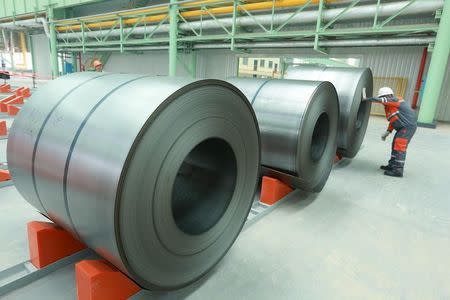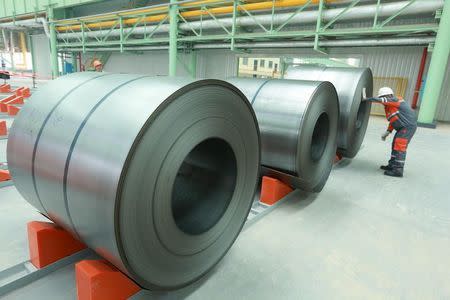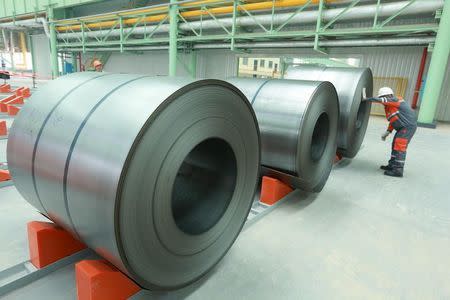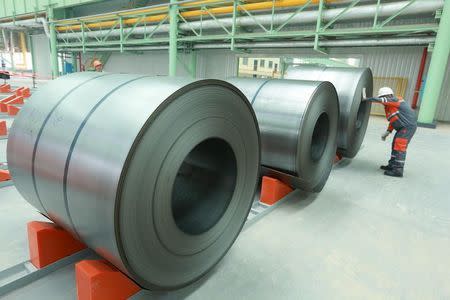China commodities output weak in first two months of 2016
By Adam Rose
BEIJING (Reuters) - China's output of key industrial commodities including coal and steel continued to shrink in the first two months of the year amid chronic oversupply, while crude oil production slipped as a global price slump took its toll.
Economic activity data also remained weak in January and -February, with factory output growth hitting the lowest since the global financial crisis, keeping pressure on policymakers to do more to avert a sharper showdown in the world's second-largest economy.
The government set an economic growth target of 6.5 percent to 7 percent for this year at the country's annual parliament, the National People's Congress, which ran this week.
"China's recent National People's Congress provided some positive news for commodity markets by stimulating domestic demand and outlining structural reforms," analysts with ANZ Research said in a commodities note on Friday.
"However, any policy support will likely be neutral for the steel and iron ore sectors."
Data from the country's statistics bureau showed on Saturday crude steel output in January and February continued to drop, falling 5.7 percent year-on-year to 121.1 million tonnes, which helped to trigger a further 10.4 percent drop in the output of coking coal, a key steel-making material.
China accounts for nearly half of global steel production but domestic mills are under heavy pressure to cut output as a result of declining demand. Output fell last year for the first time since 1981.
"Demand is basically steady and I certainly haven't seen any explosive demand or any large stimulus policies coming out from the state," Cao Huiquan, chairman of Hunan Valin Iron and Steel Group, said.
Raw coal output, which has been falling as a result of government measures to promote cleaner burning fuels, also dropped 6.4 percent from the same period a year ago to 513 million tonnes.
The statistics bureau releases only combined data for the first two months of the year because the week-long Spring Festival holiday, which is based on a traditional lunar calendar, can fall in either month.
China generated 870.2 billion kilowatt-hours (kWh) of power in January and February, rising 0.3 percent from the same period last year, with thermal power generation falling 4.3 percent amid an upsurge in hydro, the data showed on Saturday.
Total power generation in China fell for the first time in decades last year, exposing a huge nationwide capacity surplus, especially in the coal-dominated thermal power segment.
At the annual parliament this week, the delegation from China's eastern province of Jiangsu called for concrete efforts to cut overcapacity in the cement sector - a major coal and power consumer - noting that capacity was 3.5 billion tonnes, while output was only 2.35 billion tonnes last year.
While a slew of government measures and increased lending have helped boost the housing market, a huge overhang of unsold homes in smaller cities has discouraged new construction and investment. Still, real estate investment in China rose 3 percent in the first two months of 2016, compared with 1-percent growth for the whole of last year.
The statistics data also showed that output of natural gas, which is used in heating, rose 5.7 percent on year in January and February.
Crude oil throughput rose 4.6 percent on year as refiners continued to take advantage of weak global prices to import record amounts of crude, hitting 10.59 million barrels per day, down roughly 2 percent on a daily basis from a record high in December.
Crude production fell 0.6 percent in January and February to 34.11 million tonnes, or 4.15 million bpd.
Commodity analyst ICIS said earlier this month that it expects crude output to fall 1.5 percent this year amid the weak global prices, the first drop since 2009.
Implied oil demand rose 0.6 percent from the same period a year earlier to 10.51 million bpd, rising 1.9 percent from December, according to Reuters calculations using preliminary government data.
In its latest forecast, the International Energy Agency said it expects Chinese oil demand to grow 2.9 percent this year, or 331,000 bpd.
(Reporting by Adam Rose; Additional Reporting by David Stanway; Editing by Sam Holmes)






